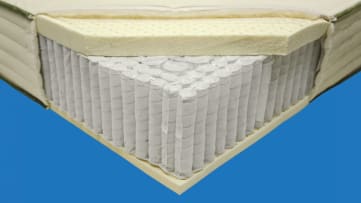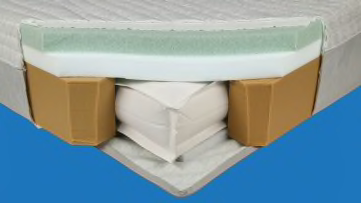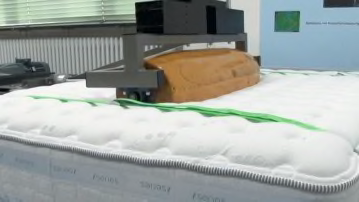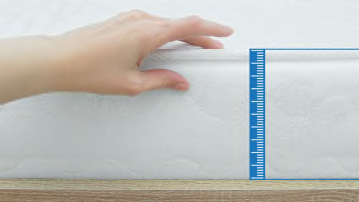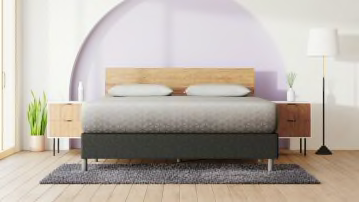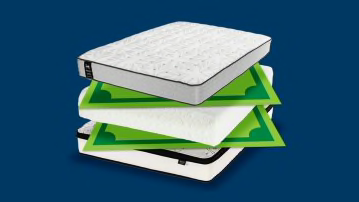Mattresses
Mattress Buying Guide
Choose the Right Mattress for Better Sleep
A good mattress can be crucial in helping you fall asleep easily and wake up refreshed. That’s why we’ve put hundreds of models through their paces—from evaluating firmness levels and spinal support to testing for heat retention and durability.
Photo: Casper

Top Mattresses Questions
Should I buy a foam, innerspring, or adjustable air mattress?
The three basic mattress types—innerspring, foam, and adjustable air—deliver very different experiences. To know which might suit you best, consider what you’ve enjoyed sleeping on in the past, the amount of bounce you like in your bed, and how far you like to sink into it.
-
Foam Mattresses
Construction Built entirely of foam—layers of either the same foam or different types of foam—to provide a cradling feel.Types Memory foam, nonmemory polyurethane foam, latexPrice $-$$$$pros & consFoam Mattresses Ratings- Good motion isolation (stability).
- Wide range of prices.
- May be difficult to move around in for some sleepers.
- Tend to retain more heat than innerspring mattresses.
-
Innerspring Mattresses
Construction A steel-coil foundation, topped with layers of fiber padding (often cotton or wool), foam, or both.Types Tight top, pillowtop, Eurotop, hybridPrice $$-$$$$pros & consInnerspring Mattresses Ratings- More resilient than foam mattresses, so you can shift positions more easily.
- Retain less heat than foam mattresses.
- Are often more budget-friendly than adjustable air mattresses.
- Innersprings tend to earn lower stability scores than all-foam mattresses.
-
Adjustable Air Mattresses
Construction Air chambers at their core, topped with a layer of foam or padding, can be inflated or deflated to adjust for firmness.Type Only one type of adjustable air mattressPrice $$$$$pros & consAdjustable Air Mattresses Ratings- Firmness level is adjustable.
- Can designate a separate air chamber on each side of a queen or king bed for a customized feel for each sleeper.
- Available features include an adjustable bed frame that lets you lower and raise the head or foot of the bed.
- Expensive.
What do the different types of foam mattresses feel like?
All foam mattresses provide a cushiony, cradling surface, but each type of foam offers a slightly different nuance in feel.


-
Memory Foam
Expect to sink very slowly into these curve-conforming layers. How slowly depends on the make of the foam and the overall construction of the mattress.
-
Nonmemory Polyurethane Foam
These layers cradle without the slow, contouring sink of memory foam—making them less cuddly but easier to move around in.
-
Latex
Constructed with the liquid from a rubber tree plant, latex layers cushion while offering a subtly springy feel.
-
Foam Combinations
Some mattresses are a mix of memory- and non-memory-foam polyurethane layers. Some mix one or both of these synthetic layers with latex. The overall feel depends on the construction of the mattress, but the top layer has the most impact on what you experience.
What size mattress should I get?
Consider the amount of space in your bedroom and who will be sleeping in the bed. Here are the measurements of the mattress sizes you’ll most frequently come across.
-
Twin 38x75 inches
Great for small children and small bedrooms, a twin-size bed comfortably fits one person.
-
Twin XL 38x80 inches
Growing teens and college students appreciate the extra legroom on a twin XL, which comfortably fits one person. It's a suitable size for a studio apartment or a cozy bedroom.
-
Full/Double 54x75 inches
Also found in guest rooms, a full bed—commonly known as a double bed—offers more width than a twin but can still fit in smaller spaces. It comfortably sleeps one person, but it can accommodate two smaller people.
-
Queen 60x80 inches
The most commonly sold mattress size, and the size we test at CR, a queen offers enough space for two people to sleep comfortably and offers plenty of room for a solo sleeper who likes to move around. Given its size, a bedroom of at least 10x10 feet is recommended.
-
King 76x80 inches
Great for couples, a king mattress offers ample room for two people to sleep comfortably and move about throughout the night without feeling restricted. These mattresses are ideal for larger bedrooms of at least 12x12 feet.
-
California King 72x84 inches
The California King is the longest of the commonly found mattresses on the market. That makes it a great fit for taller couples who want extra legroom and can compromise on the width. Like a standard king bed, these mattresses are best suited for larger bedrooms with a minimum size of 12x12 feet.
How can I tell if a particular mattress is right for me?
Mattress sellers tout an array of fancy-sounding features to convince you that their product is right for you. But according to our experts, these are the factors that truly matter.
-
Firmness Level
Photo: Sleep On LatexOne brand's "medium" might be another brand's "firm." To help you compare, we measure each mattress against an industry standard using a scale from 1 (extremely soft) to 10 (extremely firm). Check our ratings for more, and see best firm mattresses and the best soft mattresses from our tests.
-
Durability
To test for durability, we run a 300-plus-pound wood roller across the surface of each mattress 30,000 times—simulating eight to 10 years of use. Our tests found that some of the most wallet-friendly mattresses can also be quite durable. See our ratings chart for more.
-
Breathability
Photo: AvocadoSome mattresses allow more airflow than others. That means less trapped heat. Generally, innerspring models retain less heat than foam because of the coils, but how hot you sleep ultimately depends on a mattress's overall construction. See “Best Mattresses for Hot Sleepers” for more.
-
Stability
Photo: iStockStability refers to a mattress's ability to isolate motion—allowing a sleep partner (or pet or child) on one side of the mattress to shift without jostling a sleeper on the other side. Generally, foam models have better stability than innerspring. (Note: Innersprings with individually wrapped coils do better than those without.) To see details in our ratings, click "Best For" and filter for high-performing mattresses that also offer good stabilization. You can also read “Best Mattresses for Couples.”
-
Certifications
Source: GOTSThat "new mattress smell" is what you detect when volatile organic compounds (VOCs) escape into the air from the foam, upholstery, and adhesive in a mattress. In high concentrations released indoors, these chemicals can lead to negative health effects. So before using a mattress, let it off-gas with the windows open until the odor dissipates. If you’re sensitive to chemicals, have allergies, or have a respiratory condition, consider a mattress that is certified for low levels of potentially toxic chemicals. See the best low-VOC mattresses and certifications for more.
-
Support
Photo: Getty ImagesA good mattress will keep your spine aligned throughout the night, so you don't wake up feeling achy. That alignment, or support, depends on not just the mattress itself but also how it interacts with the weight of your body, how that weight is distributed, and your sleep position. We assess each mattress for its ability to support side and back sleepers as well as large and small sleepers. Explore our ratings for more, and check our reviews of the best mattresses for side sleepers and for back sleepers.
Where’s the best place to buy a mattress?
Your choice of retailer determines whether you have a range of options, how knowledgeable the salesperson is, and how easy it is to return a mattress. Our survey of more than 6,000 CR members suggests the best mattress retailers include Denver Mattress Co., Mattress Warehouse, Raymour & Flanigan, Saatva, and the Original Mattress Factory. For more, see our mattress store ratings.
Regardless of where you shop, make sure you understand the return policy. Direct-to-consumer online brands give you anywhere from 30 days to a year to try the mattress before returning it for a full refund. But some may levy a transportation or restocking fee. If you buy from a department store or specialty mattress seller, their return policy is typically honored, which can differ from what’s on the mattress brand’s website. Other physical stores may refund only a percentage of the price, or give store credit only.
How should I assess a mattress in a store?
Once you find one (or two or three) models with a firmness and feel that you like, spend at least 10 minutes on each. Ask the salesperson for a pillow. Then check the following.
- Back support: Lie on your back and focus on your spine. It should be neutral, not arched. And your hips and shoulders should feel cradled.
- Side support: Lie on each side, and use the pillow to align your neck with your spine. Your back should feel comfortably neutral and your shoulders and hips cushioned.
- Stomach support: Experts say you shouldn’t sleep on your stomach. But in case you end up that way, check that your back feels neutral, not arched. And make sure your stomach and rib cage are cradled.
- Edge support: Sit on the edge of the bed. It should stay fairly stable, so you can, say, pull on a pair of socks. Then lie on the edge to make sure you don’t slide off.
- Motion isolation: If you have a sleep partner, try the bed together. What happens when one of you shifts positions? Does it disturb the other? Is it tolerable, or will you be keeping each other awake?
What are the biggest misconceptions about mattresses?
Mattresses are a blind purchase: They all look the same, and the features that distinguish one from another are sealed inside, making it difficult for you to know exactly what you're buying, and easier for sellers to promote features that may or may not be helpful. Here, we dispel a few of the most common myths.
-
Myth: Thicker Mattresses Are Better
Photo Illustration: Consumer Reports, Getty ImagesTruth: The best mattress thickness is a matter of personal preference. A thick mattress might appear luxurious, but it's really about what's adding the height. Poor-quality fillers can be prone to sagging and softening. In our ratings the average foam mattress is about 11 inches, the average innerspring is about 13 inches, and the average adjustable air mattress is 12½ inches.
-
Myth: All Hybrids Are the Same
Photo: ZomaTruth: They vary wildly. Part innerspring and part foam, these mattresses offer the resilience of coils with the cuddle of foam. When you shop, note the number and height of the coils and thickness of the foam layers. Mattresses with a higher proportion of foam will feel more foam-forward, and those with less will feel more like an innerspring.
-
Myth: Firm Mattresses Relieve Back Pain
Photo: Adobe StockTruth: The right choice is not about the mattress itself, but how supported you feel on it. Your spine should feel aligned, not flexed or twisted—whether the mattress is firm, soft, or something in between. In fact, a Utica College study found that the best mattress for back pain is one that’s medium-firm—however the user describes it.
-
Myth: Gel Foam Mattresses Are Cooling
Photo: Tuft & NeedleTruth: They don’t necessarily retain less heat than nongel foams. That’s because while gel-infused foams might feel cool to the touch at first, they’ll eventually warm up with extended exposure to body heat. And while some foams are more breathable than others, none can actively cool you, unless equipped with a system of fans or chilled water (features more likely found in cooling mattress pads).
-
Myth: Good Mattresses Are Expensive
Photo Illustration: Lacey Browne/Consumer Reports, Getty ImagesTruth: Not necessarily. Plenty of our high-performing mattresses are in the $1,000 range, and there are even some for under $600. Mattresses that cost around $2,000 or more tend to have extras that are nice to have (such as an organic-cotton cover and latex foams) but aren’t necessarily crucial to back support or durability.
-
Myth: A Mattress Topper Can Fix an Old Mattress
Photo: Andrey Popov/Getty ImagesTruth: A mattress topper is unable to firm up a mattress that feels too soft, much less add support to an old mattress that’s lumpy or sagging. Mattress toppers are best used to dial up the plushness of a mattress that feels too firm.

















